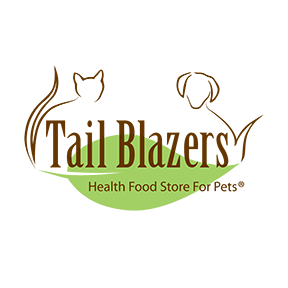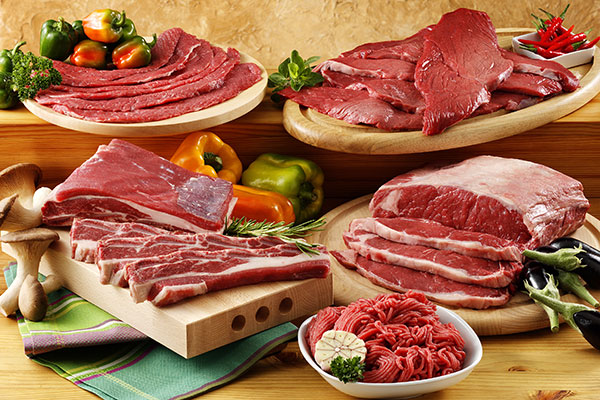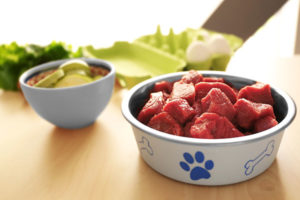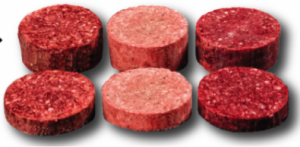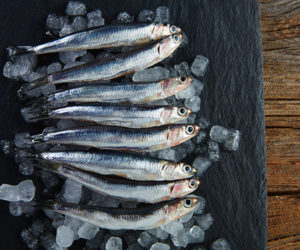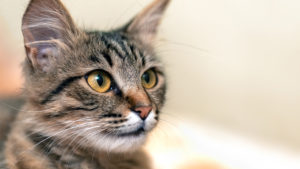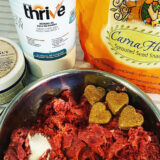Humans! Raw Food! Bacteria! Oh My!
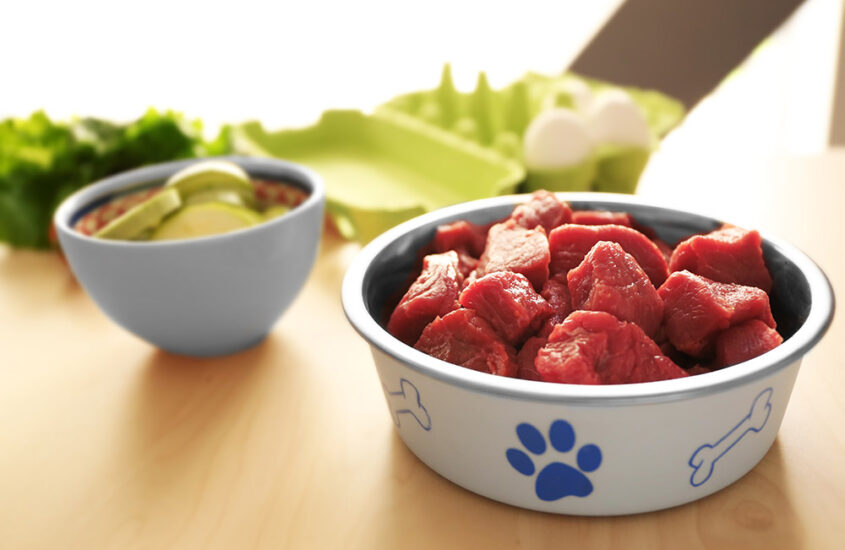
Tail Blazers was founded on sourcing and offering the most species appropriate diets available in the market. We have always heavily promoted raw (meat/bone/organ-based) diets as the most species appropriate – what do wild canines and felines eat if not raw animal prey-based diets? These are the most species appropriate for our domesticated dogs and cats as well.
One of the most common arguments against raw food diets is, you guessed it, BACTERIA and the dangers that those bugs can potentially pose to our pets and ourselves. But, how harmful is bacteria in raw pet food, and food in general? Is raw more dangerous? Are humans really at risk?
The first thing to address is raw food in general, and I am not talking about raw PET food, I am talking about raw HUMAN food. We all know that humans eat plenty of raw fruits and vegetables. Most everyone likes to bite into a crisp fresh apple or partake in a nice healthy salad. Is there bacteria present in fruits and vegetables? Yes! Most definitely there is. When the quantity of those bacteria reaches potentially harmful levels, our governments will ask food manufacturers to institute recalls to remove the potential harm from the market. There have been many recent recalls of potentially harmful bacteria like E. Coli, Salmonella and Listeria. Recent recalls include: microgreens for Listeria, salad mix for Listeria, chili powder for Salmonella, broccoli slaw for Listeria, spinach for Listeria, frozen berries for Salmonella, romaine lettuce for E.Coli. This was just over a couple of months period here in Canada and the list goes on and on. Is human health at risk? Potentially, yes. But do we protect ourselves with proper handling etc.? Also, yes.
Now, let’s take a look at meat. Unless you are a vegetarian or vegan you most definitely enjoy a good steak, some chicken wings, a nice pork loin, or a salmon filet.
Would any of you think about eating RAW MEAT?
Did you quickly answer, NO to that question? (Not even a blue rare steak?)
Humans all around the world in almost every culture eat some forms of raw MEAT (and not just a little bit of salmon sashimi or a spicy tuna roll at the local sushi joint). Let’s take a quick tour around the globe and see:
Starting in the East, Koreans eat a whole category of raw meat dishes called hwe. While most are indeed sashimi-like fish and seafood dishes, one specifically is beef and raw egg called Yookhwe. Thailand is known for raw “cooking” with dishes such as raw beef Koi Soiwhich may also contain blood or bile. In Vietnam the raw dish of choice is Boi Tai Chanhwhich are sheets of beef round (as opposed to the julienned Korean and Thai dishes).
Of course, indigenous North Americans have eaten raw meat dishes for thousands of years – things that would turn the average person’s stomach – like whale blubber and seal meat. Our neighbours to the Deep South in Texas, although known for great barbecue, will serve up a tartare-like dish called Parisa(or “tiger meat”) made from beef, bison or venison. Over in Mexico, Ceviche (which can be all kinds of raw fish, seafood or beef – specifically Carne Apache) is prepared. And further south in Chile they make Crudos, which is basically German Mett(see below) with beef instead of pork.
Over in Europe, the French of course like a good steak tartare– which is typically beef or horse (originating from the Tartars). The Dutch love a raw oxen sausage called Ossenworst, while their German neighbours enjoy Mett, a pork (yes, raw pork) spread. To the south, Italians eat beef Carpaccio, probably second in fame only to Tartare.
When we dip down into Africa, Ethiopians serve raw beef called Kitfo as well as Gored Gored(an unmarinated version of Kitfo). In the Middle East, Kibbeh Nayyeh, a raw ground meat dish is eaten, as is a variant known as Cig KofteIn Turkey/Armenia.
I am saving the most SHOCKING for last. We now return to Asia, specifically Japan, where we know they love their raw fish and seafood – sushi and sashimi – but there is a long tradition of raw meat dishes called Basashi. This includes raw beef – gyu tataki, horse – sakuranikuliterally “cherry blossom meat”, venison – momoji“maple leaf” (a bit of Canadian influence?), boar – botan or “peony” and…RAW CHICKEN a properly handled and prepared delicacy known as toriwasa.
If humans around the world eat raw meat (*for more interesting research do a quick Google for the guy that has eaten ONLY raw meat – including rotten meat for the probiotic effects – for the past 5 years (article from 2013)), why wouldn’t you feed your companion carnivore the diet it was born to eat?
Have I convinced you that raw meat is SAFE?
Let’s look more into bacteria since we are told by many that we should be afraid of these microscopic bugs.
Would you be shocked or surprised to read that potentially harmful bacteria are all around you right now? Would you be shocked to know that these little “killers” are ON and IN you right now?
We took our walk around the world looking for raw meat eaters, we will now take a tour of your home looking for BACTERIA. There are potentially harmful bacteria all over your house – these include the same bacteria – Salmonella,E. Coli andListeriathat are found on RECALLED food products, as well as Staphylococcus aureus, or staph. You will also find potentially harmful yeasts and molds, but those are another blog topic.
As you would expect, your kitchen is teeming with bacteria. Cutting boards, coffee makers, wash clothes, sponges, the inside of your refrigerator (especially places in contact with uncooked food), kitchen sinks and countertops, as well as fridge handles, light switches, stove knobs and microwave handles all have them. Your bathroom is another petri dish. You will find these potentially harmful bacteria in the shower, in drains, on the floor around the toilet, on bath towels and yes, on your toothbrush. Towels and even wet laundry left for as a little as 30 minutes in the washer all have bacteria, yeast and molds. Personal items are also great experiments in microbiology – makeup bags and makeup applicators/products, computer keyboards, cell phones/phones, remote controls, keys, wallets, money, lunch boxes, and food containers…the list is almost endless. We are designed to be able to handle and even require bacteria to thrive!
Most people know that we have good bacteria in our guts – so called probiotics, but did you ever realize that your own person is covered in and full of potentially harmful bacteria? The living body is made up of what is known as the “microbiome”. Your own personal microbiome consists of TRILLIONS of microorganisms that outnumber your own human cells by 10 to 1. WHAT? Yes. TEN TO ONE. One of the fascinating features of the microbiome is that different body sites have different communities of microorganisms that are as different from each other as the differences between microbial communities in oceans and deserts. More than 10,000 microbial species inhabit the human “ecosystem”.
Good/helpful bacteria in your body include: Lactobacillus/Döderlein’s bacillusthat utilize and ferment lactose (“milk sugar”) to create usable metabolic products in your body; Bifidobacteriumproduce acetic acid and help maintain pH (acidity) in the intestines; Escherichia coli (E. coli) (yes, the same one that we hear about as being dangerous in YOUR poop and in your dog’s poop) is required by your body to help in the breakdown of undigested monosaccharide sugars and thus aid digestion. E. Coli also produce vitamin K and biotin which are essential for a variety of cellular processes required for life.
Bad bacteria can and do exist at low levels in your body without causing harm or can grow too much and wreak havoc. Staphylococcus aureuscan cause something as simple as a pimple or as serious as pneumonia or toxic shock syndrome. P. gingivalispresent naturally in your mouth can cause gum disease and was recently linked to pancreatic cancer. Similarly, when not suppressed by good bacteria, Klebsiella pneumoniacan cause colitis, and subsequently lead to colorectal cancer. Helicobacter pylori that colonizes the stomach lining, is the leading cause for gastritis and peptic ulcers. It produces cytotoxins and ammonia which damage the stomach epithelium leading to abdominal pain, nausea, vomiting, and bloating. H. pyloriis present in halfof the world’s population, however, most of them are asymptomatic while only a few develop gastritis and ulcers.
The single celled world of bacteria is the oldest on the planet and we can thank these little critters for allowing us to digest our food and survive. They aren’t all bad!
If “weak” omnivorous humans cannot only eat raw meat, but live surrounded with, and filled by, these bacteria, why would we believe people who try to convince us that our companion carnivore friends cannot handle the species appropriate diet they were designed to eat. You are a smart human. You keep things clean and sterile when you handle raw meats in your home (or at least you should be but based on the studies generating the bacteria data above you aren’t very good at it). Bacteria CAN cause illness and disease. Bacteria also allow us to LIVE. Your companion animal is even MORE capable of handling “bad” bacteria than you are. Nature made them that way. From antibacterial enzymes in their mouths (e.g. lysozyme and peroxidase) to highly acidic and shorter digestive tracts with digestive enzymes and the right GOOD bacteria, dogs and cats have the physiology to eat, digest and thrive on raw meat, bones and organs. Don’t be scared of bacteria…RESPECT bacteria. Choose the most species appropriate diet for your companion animal. Ask your local Tail Blazers about a raw food diet.
By P. Andrew Outinen M.Sc., M.B.A.
Owner of Tail Blazers Etobicoke and Tail Blazers Heartland (Mississauga)
About the Author:
I come from a 20 year career in the human health care field. Combined with my formal, post-high school education, I have spent more than half of my life studying, researching and promoting many of our amazing advancements in research, science and medicine. I have a Bachelor of Science in Pharmacology and Toxicology. I have a Master of Science in Medical Sciences. I am a published researcher. I have been a basic researcher, clinical researcher, and heavily involved in the sales and promotion of some of the most important medical devices we as humans have ever invented. I have chosen to own Tail Blazers stores because there is nothing more fulfilling than improving the life of a companion dog or cat.
